Strength and Water Absorption of Sustainable Concrete Produced with Recycled Basaltic Concrete Aggregates and Powder
Abstract
1. Introduction
2. Research Significance
3. Experimental Work
3.1. Material Properties
3.1.1. Natural Aggregates
3.1.2. Recycled Concrete Aggregates
3.1.3. Recycled Concrete Powder
3.1.4. Cement
3.2. Validation of the Material Chemical Composition as Natural Pozzolana
3.3. Mix Proportions and Mixing Procedure
3.4. Test Method
4. Results and Discussions
4.1. Concrete Compressive Strength
4.1.1. Effect of the CRCA
4.1.2. Effect of the FRCA
4.1.3. Effect of the RCP
4.2. Concrete Tensile Strength
4.2.1. Effect of CRCA
4.2.2. Effect of FRCA
4.2.3. Effect of the RCP
4.3. Water Absorption
5. Theoretical and Experimental Comparisons
6. Conclusions
- With increasing curing time, concrete compressive and tensile strengths increased regardless of the concrete components (with or without recycled materials). The concrete strength increased with increasing Tc from 7 to 28 days with a higher percentage than increasing Tc from 28 to 56 days. This may be because of the higher hydration rate of the cement during the first 28 days compared to the later days.
- Partial substitution of recycled aggregate for NA reduced concrete strength with varying percentages depending on the size and source of recycled aggregate, especially after 56 days. After 28 days, the maximum reduction in concrete strength when CRCA or FRCA was incorporated up to 80% was 7.6% and 4.6%, respectively, while the maximum reduction in strength was 13.2% and 9.4% for mixtures with CRCA and FRCA, respectively. After 56 days, the mixes with 40% FRCA achieved almost the same M0 compressive strength (99.5%).
- Increasing RCP from 5 to 10% enhanced the concrete strength at 28 and 56 days due to late hydration of RCP. After 28 days, the concrete strength was about 89% and 99.3% of the strength of M0, while the strength after 56 days was 89.6 and 95.2% of the strength of M0 when the RCP replaced the cement by 5% and 10%, respectively. The maximum strength reduction was 12.2% and 15.2% compared to M0 after 28 and 56 days, respectively, when the RCP = 20%.
- Compared to the M0 mixtures, the tensile strength increased or decreased depending on the proportion and type of recycled material and the curing time. After 56 days, the tensile strength augmented by 1.98%, 5.40% and 17.2% (maximum values) when the cement was substituted by CRCA, FRCA, and RCP, respectively.
- Generally, the values of WA decreased with increasing Tc from 28 to 56 days. The mixes in which coarse RCA was incorporated showed higher WA values than those of M0. Consequently, WA decreased for mixes integrated FRCA and RCP compared to that of integrated CRCA.
- The obtained results and comparisons encourage the use of recycled aggregates and powders as a substitute material for NA and cement to produce sustainable/green concrete.
- The recycled aggregates could obtain nearly the same mechanical properties of mixes with natural aggregate. Conversely, the use of RCP to replace cement also reduces the cost and CO2 emission from the cement production process. So, the use of recycled aggregates and powder to replace the natural aggregate and cement, respectively could be considered an efficient method to lower the structures’ cost, their impact on the environment, and improves their sustainability.
- The transportation costs of natural aggregate and other construction materials have significant effects on the economic analysis. The use of recycled aggregate in re-building, demolition and retrofitting of structures could be very effective as the source of the old concrete is near to the construction site.
Author Contributions
Funding
Institutional Review Board Statement
Informed Consent Statement
Data Availability Statement
Conflicts of Interest
References
- Xuan, D.; Poon, C.S.; Zheng, W. Management and sustainable utilization of processing wastes from ready-mixed concrete plants in construction: A review. Resour. Conserv. Recycl. 2018, 136, 238–247. [Google Scholar] [CrossRef]
- Martínez-García, R.; de Rojas, M.I.S.; Del Pozo, J.M.M.; Fraile-Fernández, F.J.; Juan-Valdés, A. Evaluation of mechanical characteristics of cement mortar with fine recycled concrete aggregates (FRCA). Sustainability 2021, 13, 414. [Google Scholar] [CrossRef]
- Pacheco-Torgal, F. High tech startup creation for energy efficient built environment. Renew. Sustain. Energy Rev. 2017, 71, 618–629. [Google Scholar] [CrossRef]
- Tam, V.W.Y.; Soomro, M.; Evangelista, A.C.J. A review of recycled aggregate in concrete applications (2000–2017). Constr. Build. Mater. 2018, 172, 272–292. [Google Scholar] [CrossRef]
- Ginga, C.P.; Ongpeng, J.M.C.; Daly, M.K.M. Circular economy on construction and demolition waste: A literature review on material recovery and production. Materials 2020, 13, 2970. [Google Scholar] [CrossRef] [PubMed]
- Yu, B.; Wang, J.; Li, J.; Lu, W.; Li, C.Z.; Xu, X. Quantifying the potential of recycling demolition waste generated from urban renewal: A case study in Shenzhen, China. J. Clean. Prod. 2020, 247. [Google Scholar] [CrossRef]
- Turk, J.; Cotič, Z.; Mladenovič, A.; Šajna, A. Environmental evaluation of green concretes versus conventional concrete by means of LCA. Waste Manag. 2015. [Google Scholar] [CrossRef]
- Liew, K.M.; Sojobi, A.O.; Zhang, L.W. Green concrete: Prospects and challenges. Constr. Build. Mater. 2017. [Google Scholar] [CrossRef]
- Zhao, Y.; Yu, M.; Xiang, Y.; Kong, F.; Li, L. A sustainability comparison between green concretes and traditional concrete using an emergy ternary diagram. J. Clean. Prod. 2020, 256, 120421. [Google Scholar] [CrossRef]
- Dang, J.; Zhao, J. Influence of waste clay bricks as fine aggregate on the mechanical and microstructural properties of concrete. Constr. Build. Mater. 2019, 228, 116757. [Google Scholar] [CrossRef]
- Karimaei, M.; Dabbaghi, F.; Sadeghi-Nik, A.; Dehestani, M. Mechanical performance of green concrete produced with untreated coal waste aggregates. Constr. Build. Mater. 2020, 233, 117264. [Google Scholar] [CrossRef]
- Çakir, O. Experimental analysis of properties of recycled coarse aggregate (RCA) concrete with mineral additives. Constr. Build. Mater. 2014. [Google Scholar] [CrossRef]
- Majhi, R.K.; Nayak, A.N.; Mukharjee, B.B. Development of sustainable concrete using recycled coarse aggregate and ground granulated blast furnace slag. Constr. Build. Mater. 2018. [Google Scholar] [CrossRef]
- Majhi, R.K.; Nayak, A.N. Bond, durability and microstructural characteristics of ground granulated blast furnace slag based recycled aggregate concrete. Constr. Build. Mater. 2019. [Google Scholar] [CrossRef]
- De Juan, M.S.; Gutiérrez, P.A. Study on the influence of attached mortar content on the properties of recycled concrete aggregate. Constr. Build. Mater. 2009. [Google Scholar] [CrossRef]
- Casuccio, M.; Torrijos, M.C.; Giaccio, G.; Zerbino, R. Failure mechanism of recycled aggregate concrete. Constr. Build. Mater. 2008. [Google Scholar] [CrossRef]
- Corinaldesi, V. Mechanical and elastic behaviour of concretes made of recycled-concrete coarse aggregates. Constr. Build. Mater. 2010. [Google Scholar] [CrossRef]
- Pani, L.; Francesconi, L.; Rombi, J.; Mistretta, F.; Sassu, M.; Stochino, F. Effect of parent concrete on the performance of recycled aggregate concrete. Sustainability 2020, 12, 9399. [Google Scholar] [CrossRef]
- Tabsh, S.W.; Abdelfatah, A.S. Influence of recycled concrete aggregates on strength properties of concrete. Constr. Build. Mater. 2009. [Google Scholar] [CrossRef]
- Malešev, M.; Radonjanin, V.; Marinković, S. Recycled concrete as aggregate for structural concrete production. Sustainability 2010, 2, 1204–1225. [Google Scholar] [CrossRef]
- Rao, A.; Jha, K.N.; Misra, S. Use of aggregates from recycled construction and demolition waste in concrete. Resour. Conserv. Recycl. 2007. [Google Scholar] [CrossRef]
- Wagih, A.M.; El-Karmoty, H.Z.; Ebid, M.; Okba, S.H. Recycled construction and demolition concrete waste as aggregate for structural concrete. HBRC J. 2013. [Google Scholar] [CrossRef]
- Etxeberria, M.; Vázquez, E.; Marí, A.; Barra, M. Influence of amount of recycled coarse aggregates and production process on properties of recycled aggregate concrete. Cem. Concr. Res. 2007. [Google Scholar] [CrossRef]
- Zhang, W.; Ingham, J.M. Using Recycled Concrete Aggregates in New Zealand Ready-Mix Concrete Production. J. Mater. Civ. Eng. 2010. [Google Scholar] [CrossRef]
- Behera, M.; Bhattacharyya, S.K.; Minocha, A.K.; Deoliya, R.; Maiti, S. Recycled aggregate from C&D waste & its use in concrete—A breakthrough towards sustainability in construction sector: A review. Constr. Build. Mater. 2014. [Google Scholar] [CrossRef]
- Yang, H.; Qin, Y.; Liao, Y.; Chen, W. Shear behavior of recycled aggregate concrete after exposure to high temperatures. Constr. Build. Mater. 2016. [Google Scholar] [CrossRef]
- Otsuki, N.; Miyazato, S.; Yodsudjai, W. Influence of Recycled Aggregate on Interfacial Transition Zone, Strength, Chloride Penetration and Carbonation of Concrete. J. Mater. Civ. Eng. 2003. [Google Scholar] [CrossRef]
- Etxeberria, M.; Vázquez, E.; Marí, A. Microstructure analysis of hardened recycled aggregate concrete. Mag. Concr. Res. 2006. [Google Scholar] [CrossRef]
- Etxeberria, M.; Mari, A.R.; Vazquez, E. Recycled aggregate concrete as structural material. Mater. Struct. Constr. 2007, 40, 529–541. [Google Scholar] [CrossRef]
- Li, W.; Long, C.; Tam, V.W.Y.; Poon, C.; Hui, W. Effects of nano-particles on failure process and microstructural properties of recycled aggregate concrete. Constr. Build. Mater. 2017, 142, 42–50. [Google Scholar] [CrossRef]
- Katz, A. Properties of concrete made with recycled aggregate from partially hydrated old concrete. Cem. Concr. Res. 2003, 33, 703–711. [Google Scholar] [CrossRef]
- Li, W.; Luo, Z.; Sun, Z.; Hu, Y.; Duan, W.H. Numerical modelling of plastic–damage response and crack propagation in RAC under uniaxial loading. Mag. Concr. Res. 2018, 70, 459–472. [Google Scholar] [CrossRef]
- Silva, R.V.; de Brito, J.; Dhir, R.K. Establishing a relationship between modulus of elasticity and compressive strength of recycled aggregate concrete. J. Clean. Prod. 2016, 112, 2171–2186. [Google Scholar] [CrossRef]
- Silva, R.V.; De Brito, J.; Dhir, R.K. The influence of the use of recycled aggregates on the compressive strength of concrete: A review. Eur. J. Environ. Civ. Eng. 2014. [Google Scholar] [CrossRef]
- Silva, R.V.; De Brito, J.; Dhir, R.K. Tensile strength behaviour of recycled aggregate concrete. Constr. Build. Mater. 2015, 83, 108–118. [Google Scholar] [CrossRef]
- Majhi, R.K.; Nayak, A.N. Properties of Concrete Incorporating Coal Fly Ash and Coal Bottom Ash. J. Inst. Eng. Ser. A 2019. [Google Scholar] [CrossRef]
- Satpathy, H.P.; Patel, S.K.; Nayak, A.N. Development of sustainable lightweight concrete using fly ash cenosphere and sintered fly ash aggregate. Constr. Build. Mater. 2019. [Google Scholar] [CrossRef]
- Evangelista, L.; de Brito, J. Mechanical behaviour of concrete made with fine recycled concrete aggregates. Cem. Concr. Compos. 2007. [Google Scholar] [CrossRef]
- Flower, D.J.M.; Sanjayan, J.G. Green house gas emissions due to concrete manufacture. Int. J. Life Cycle Assess. 2007. [Google Scholar] [CrossRef]
- Estanqueiro, B.; Dinis Silvestre, J.; de Brito, J.; Duarte Pinheiro, M. Environmental life cycle assessment of coarse natural and recycled aggregates for concrete. Eur. J. Environ. Civ. Eng. 2018. [Google Scholar] [CrossRef]
- Mah, C.M.; Fujiwara, T.; Ho, C.S. Life cycle assessment and life cycle costing toward eco-efficiency concrete waste management in Malaysia. J. Clean. Prod. 2018. [Google Scholar] [CrossRef]
- Wijayasundara, M.; Mendis, P.; Crawford, R.H. Net incremental indirect external benefit of manufacturing recycled aggregate concrete. Waste Manag. 2018. [Google Scholar] [CrossRef] [PubMed]
- Marinković, S.; Radonjanin, V.; Malešev, M.; Ignjatović, I. Comparative environmental assessment of natural and recycled aggregate concrete. Waste Manag. 2010. [Google Scholar] [CrossRef] [PubMed]
- Braga, A. Comparative Analysis of the Life Cycle Assessment of Conventional and Recycled Aggregate Concrete; Instituto Superior Tecnico—University of Lisbon: Lisbon, Portugal, 2015. (In Portuguese) [Google Scholar]
- Khatib, J.M. Properties of concrete incorporating fine recycled aggregate. Cem. Concr. Res. 2005. [Google Scholar] [CrossRef]
- Kou, S.C.; Poon, C.S. Properties of concrete prepared with crushed fine stone, furnace bottom ash and fine recycled aggregate as fine aggregates. Constr. Build. Mater. 2009. [Google Scholar] [CrossRef]
- Evangelista, L.; de Brito, J. Durability performance of concrete made with fine recycled concrete aggregates. Cem. Concr. Compos. 2010. [Google Scholar] [CrossRef]
- Fan, C.C.; Huang, R.; Hwang, H.; Chao, S.J. Properties of concrete incorporating fine recycled aggregates from crushed concrete wastes. Constr. Build. Mater. 2016. [Google Scholar] [CrossRef]
- Dapena, E.; Alaejos, P.; Lobet, A.; Pérez, D. Effect of Recycled Sand Content on Characteristics of Mortars and Concretes. J. Mater. Civ. Eng. 2011. [Google Scholar] [CrossRef]
- Zhao, Z.; Remond, S.; Damidot, D.; Xu, W. Influence of fine recycled concrete aggregates on the properties of mortars. Constr. Build. Mater. 2015. [Google Scholar] [CrossRef]
- Gholampour, A.; Zheng, J.; Ozbakkaloglu, T. Development of waste-based concretes containing foundry sand, recycled fine aggregate, ground granulated blast furnace slag and fly ash. Constr. Build. Mater. 2021, 267, 121004. [Google Scholar] [CrossRef]
- Tamanna, N.; Tuladhar, R.; Sivakugan, N. Performance of recycled waste glass sand as partial replacement of sand in concrete. Constr. Build. Mater. 2020, 239, 117804. [Google Scholar] [CrossRef]
- Steyn, Z.C.; Babafemi, A.J.; Fataar, H.; Combrinck, R. Concrete containing waste recycled glass, plastic and rubber as sand replacement. Constr. Build. Mater. 2021, 269, 121242. [Google Scholar] [CrossRef]
- Uncik, S.; Kmecova, V. The effect of basalt powder on the properties of cement composites. Procedia Eng. 2013, 65, 51–56. [Google Scholar] [CrossRef]
- Ren, P.; Li, B.; Yu, J.-G.; Ling, T.-C. Utilization of recycled concrete fines and powders to produce alkali-activated slag concrete blocks. J. Clean. Prod. 2020. [Google Scholar] [CrossRef]
- Shahrour, N.; Allouzi, R. Shear behavior of captive- and short- column effects using different basalt aggregate contents. J. Build. Eng. 2020, 32, 101508. [Google Scholar] [CrossRef]
- Kurańska, M.; Barczewski, M.; Uram, K.; Lewandowski, K.; Prociak, A.; Michałowski, S. Basalt waste management in the production of highly effective porous polyurethane composites for thermal insulating applications. Polym. Test. 2019, 76, 90–100. [Google Scholar] [CrossRef]
- Ashish, D.K.; Verma, S.K. Determination of optimum mixture design method for self-compacting concrete: Validation of method with experimental results. Constr. Build. Mater. 2019. [Google Scholar] [CrossRef]
- Jani, Y.; Hogland, W. Waste glass in the production of cement and concrete—A review. J. Environ. Chem. Eng. 2014. [Google Scholar] [CrossRef]
- Zaidi, K.A.; Ram, S.; Gautam, M.K. Utilisation of glass powder in high strength copper slag concrete. Adv. Concr. Constr. 2017. [Google Scholar] [CrossRef]
- Chen, G.; Lee, H.; Young, K.L.; Yue, P.L.; Wong, A.; Tao, T.; Choi, K.K. Glass recycling in cement production-an innovative approach. Waste Manag. 2002. [Google Scholar] [CrossRef]
- Xu, J.; Zhao, X.; Yu, Y.; Xie, T.; Yang, G.; Xue, J. Parametric sensitivity analysis and modelling of mechanical properties of normal- and high-strength recycled aggregate concrete using grey theory, multiple nonlinear regression and artificial neural networks. Constr. Build. Mater. 2019, 211, 479–491. [Google Scholar] [CrossRef]
- ASTM International. ASTM C33 Standard Specification for Concrete Aggregates; ASTM International: West Conshohocken, PA, USA, 2010. [Google Scholar]
- Ghorbani, S.; Sharifi, S.; Ghorbani, S.; Tam, V.W.; de Brito, J.; Kurda, R. Effect of crushed concrete waste’s maximum size as partial replacement of natural coarse aggregate on the mechanical and durability properties of concrete. Resour. Conserv. Recycl. 2019. [Google Scholar] [CrossRef]
- American Concrete Institute. ACI 211.1 Standard Practice for Selecting Proportions for Normal, Heavyweight, and Mass Concrete (ACI 211.1-91); American Concrete Institute: Farmington Hills, MI, USA, 2002. [Google Scholar]
- British Standards Institution. BS EN 12390-3:2009 Testing Hardened Concrete, Part 3: Compressive Strength of Test Specimens; British Standards Institution: London, UK, 2009. [Google Scholar]
- Ince, R. Determination of concrete fracture parameters based on peak-load method with diagonal split-tension cubes. Eng. Fract. Mech. 2012. [Google Scholar] [CrossRef]
- Zhang, S.P.; Zong, L. Evaluation of relationship between water absorption and durability of concrete materials. Adv. Mater. Sci. Eng. 2014, 2014. [Google Scholar] [CrossRef]
- Gupta, N.; Gupta, A.; Saxena, K.K.; Shukla, A.; Goyal, S.K. Mechanical and durability properties of geopolymer concrete composite at varying superplasticizer dosage. Mater. Today Proc. 2020. [Google Scholar] [CrossRef]
- De Schutter, G.; Audenaert, K. Evaluation of water absorption of concrete as a measure for resistance against carbonation and chloride migration. Mater. Struct. Constr. 2004, 37, 591–596. [Google Scholar] [CrossRef]
- ASTM International. ASTM C642-13 Standard Test Method for Density, Absorption, and Voids in Hardened Concrete; ASTM International: West Conshohocken, PA, USA, 2013. [Google Scholar]
- Ali, B.; Qureshi, L.A. Durability of recycled aggregate concrete modified with sugarcane molasses. Constr. Build. Mater. 2019. [Google Scholar] [CrossRef]
- Ali, B.; Qureshi, L.A. Influence of glass fibers on mechanical and durability performance of concrete with recycled aggregates. Constr. Build. Mater. 2019. [Google Scholar] [CrossRef]
- Kou, S.C.; Poon, C.S.; Agrela, F. Comparisons of natural and recycled aggregate concretes prepared with the addition of different mineral admixtures. Cem. Concr. Compos. 2011. [Google Scholar] [CrossRef]
- Koushkbaghi, M.; Kazemi, M.J.; Mosavi, H.; Mohseni, E. Acid resistance and durability properties of steel fiber-reinforced concrete incorporating rice husk ash and recycled aggregate. Constr. Build. Mater. 2019. [Google Scholar] [CrossRef]
- Xiao, J.; Li, W.; Sun, Z.; Lange, D.A.; Shah, S.P. Properties of interfacial transition zones in recycled aggregate concrete tested by nanoindentation. Cem. Concr. Compos. 2013. [Google Scholar] [CrossRef]
- Wang, H.L.; Wang, J.J.; Sun, X.Y.; Jin, W.L. Improving performance of recycled aggregate concrete with superfine pozzolanic powders. J. Cent. South Univ. 2013. [Google Scholar] [CrossRef]
- Gorjinia, A.; Shafigh, P.; Moghimi, M.; Bin, H. The role of 0–2 mm fine recycled concrete aggregate on the compressive and splitting tensile strengths of recycled concrete aggregate concrete. J. Mater. 2014, 64, 345–354. [Google Scholar] [CrossRef]
- Rahman, I.A. Assessment of Recycled Aggregate Concrete. Mod. Appl. Sci. 2009, 3, 47–54. [Google Scholar]
- Pedro, D.; de Brito, J.; Evangelista, L. Evaluation of high-performance concrete with recycled aggregates: Use of densified silica fume as cement replacement. Constr. Build. Mater. 2017. [Google Scholar] [CrossRef]
- Wu, Z.; Shi, C.; Khayat, K.H. Influence of silica fume content on microstructure development and bond to steel fiber in ultra-high strength cement-based materials (UHSC). Cem. Concr. Compos. 2016. [Google Scholar] [CrossRef]
- Karthikeyan, B.; Dhinakaran, G. Influence of ultrafine TiO2 and silica fume on performance of unreinforced and fiber reinforced concrete. Constr. Build. Mater. 2018. [Google Scholar] [CrossRef]
- Hossain, F.M.Z.; Shahjalal, M.; Islam, K.; Tiznobaik, M.; Alam, M.S. Mechanical properties of recycled aggregate concrete containing crumb rubber and polypropylene fiber. Constr. Build. Mater. 2019, 225, 983–996. [Google Scholar] [CrossRef]
- Ahmadi, M.; Farzin, S.; Hassani, A.; Motamedi, M. Mechanical properties of the concrete containing recycled fibers and aggregates. Constr. Build. Mater. 2017, 144, 392–398. [Google Scholar] [CrossRef]
- Das, C.S.; Dey, T.; Dandapat, R.; Mukharjee, B.B.; Kumar, J. Performance evaluation of polypropylene fibre reinforced recycled aggregate concrete. Constr. Build. Mater. 2018, 189, 649–659. [Google Scholar] [CrossRef]
- Lima, C.; Caggiano, A.; Faella, C.; Martinelli, E.; Pepe, M.; Realfonzo, R. Physical properties and mechanical behaviour of concrete made with recycled aggregates and fly ash. Constr. Build. Mater. 2013, 47, 547–559. [Google Scholar] [CrossRef]
- Somna, R.; Jaturapitakkul, C.; Amde, A.M. Effect of ground fly ash and ground bagasse ash on the durability of recycled aggregate concrete. Cem. Concr. Compos. 2012, 34, 848–854. [Google Scholar] [CrossRef]
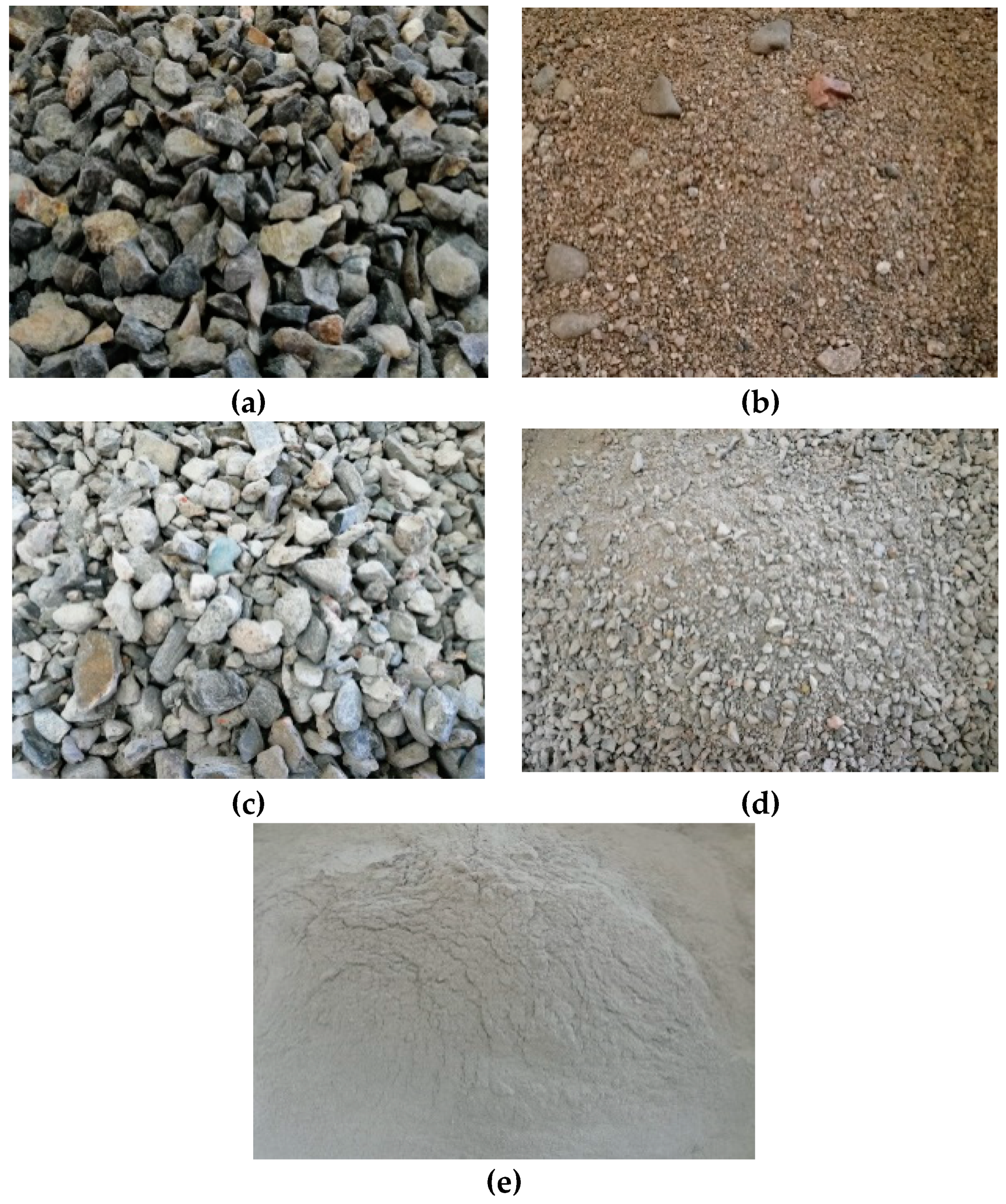
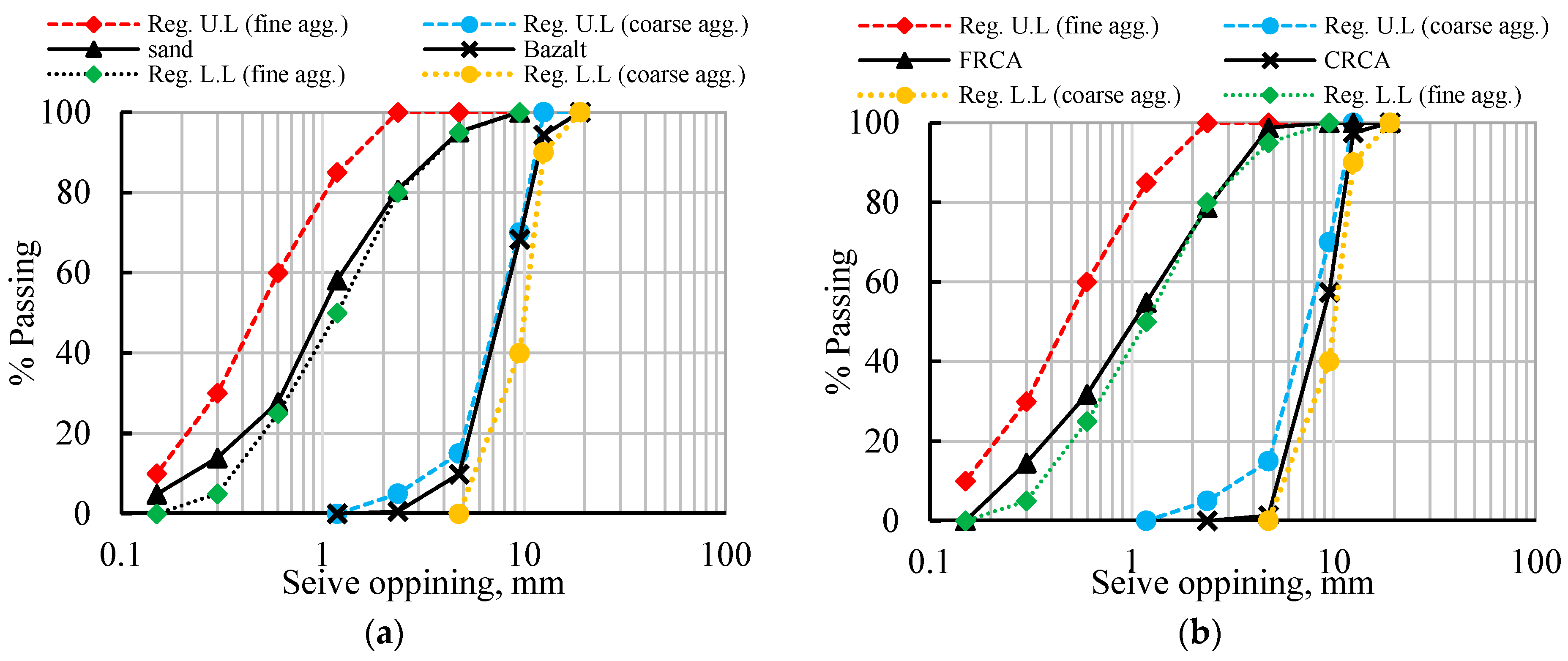
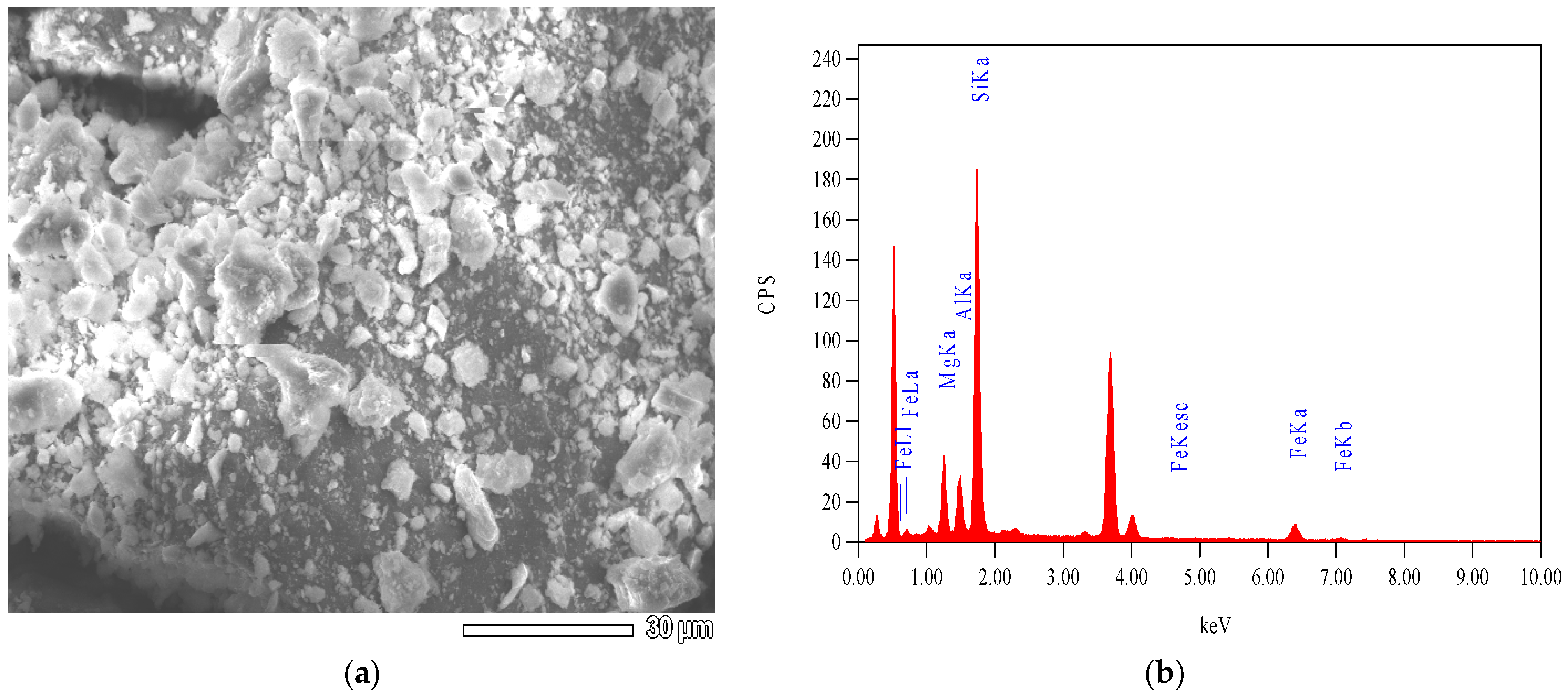
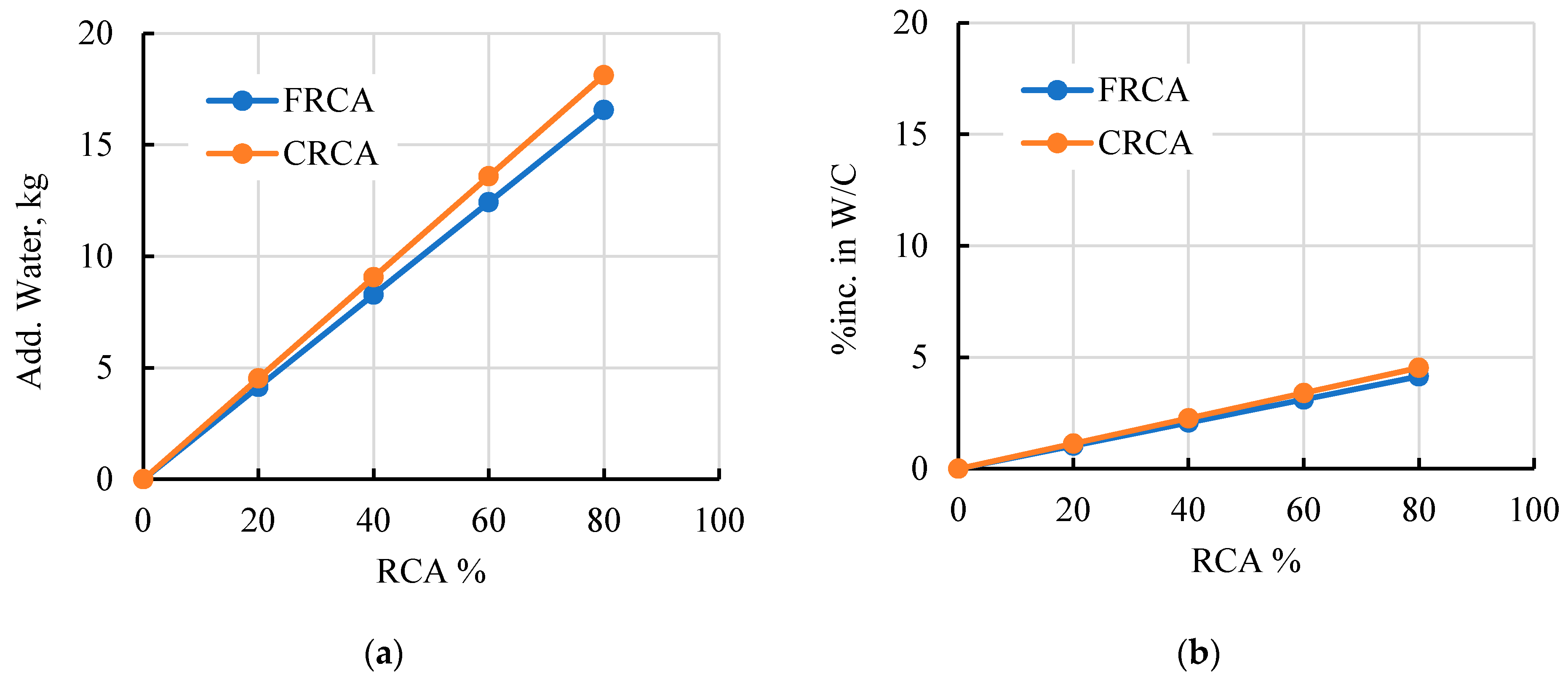
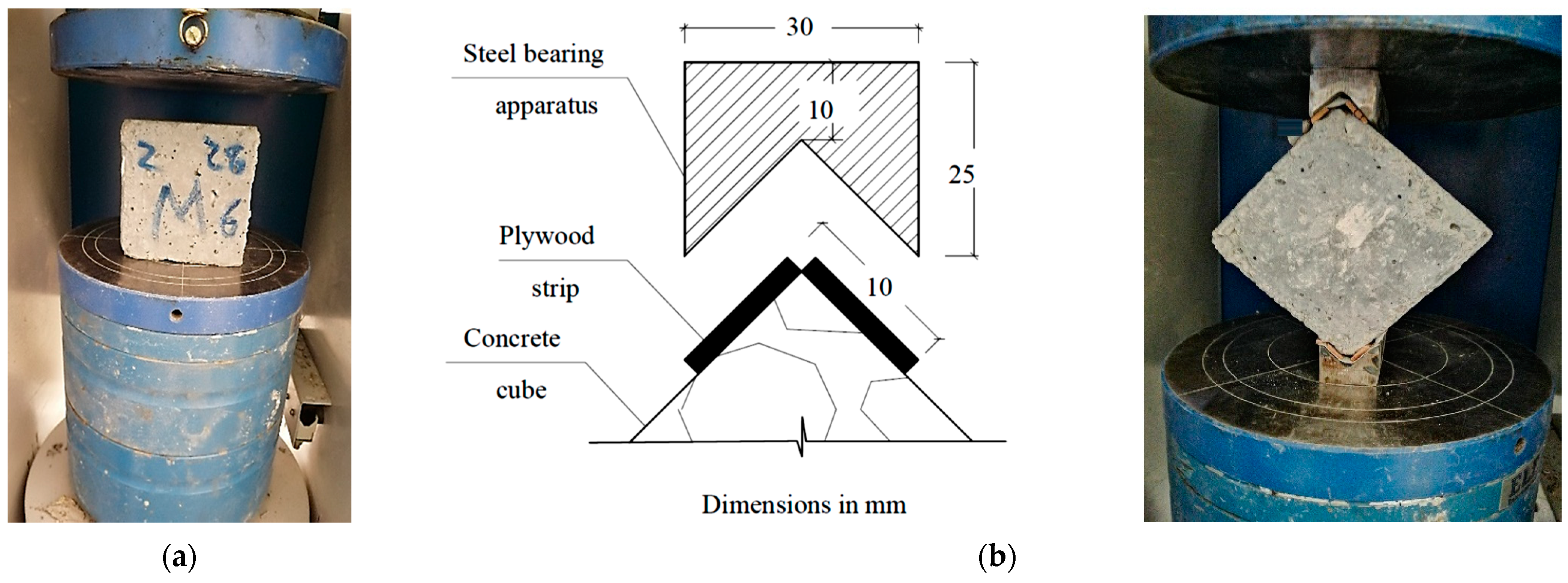
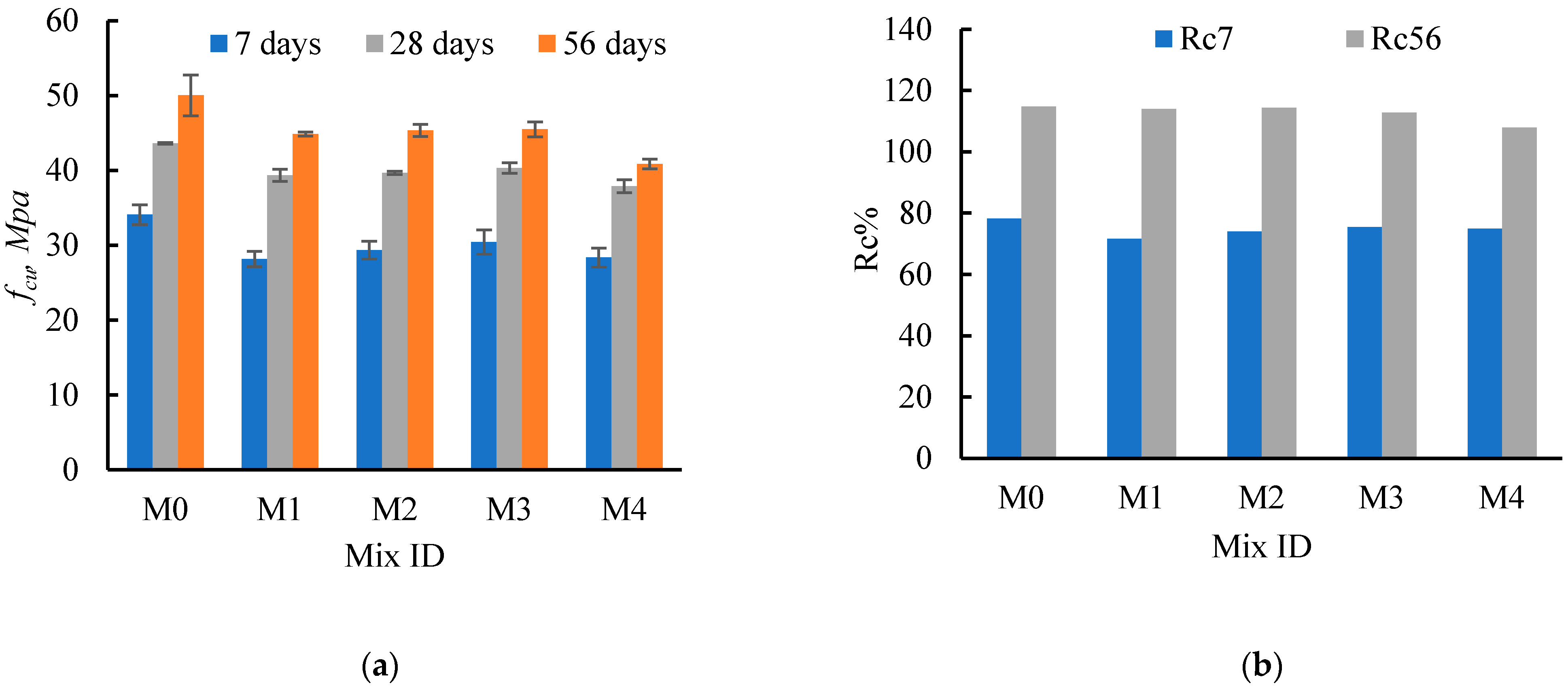
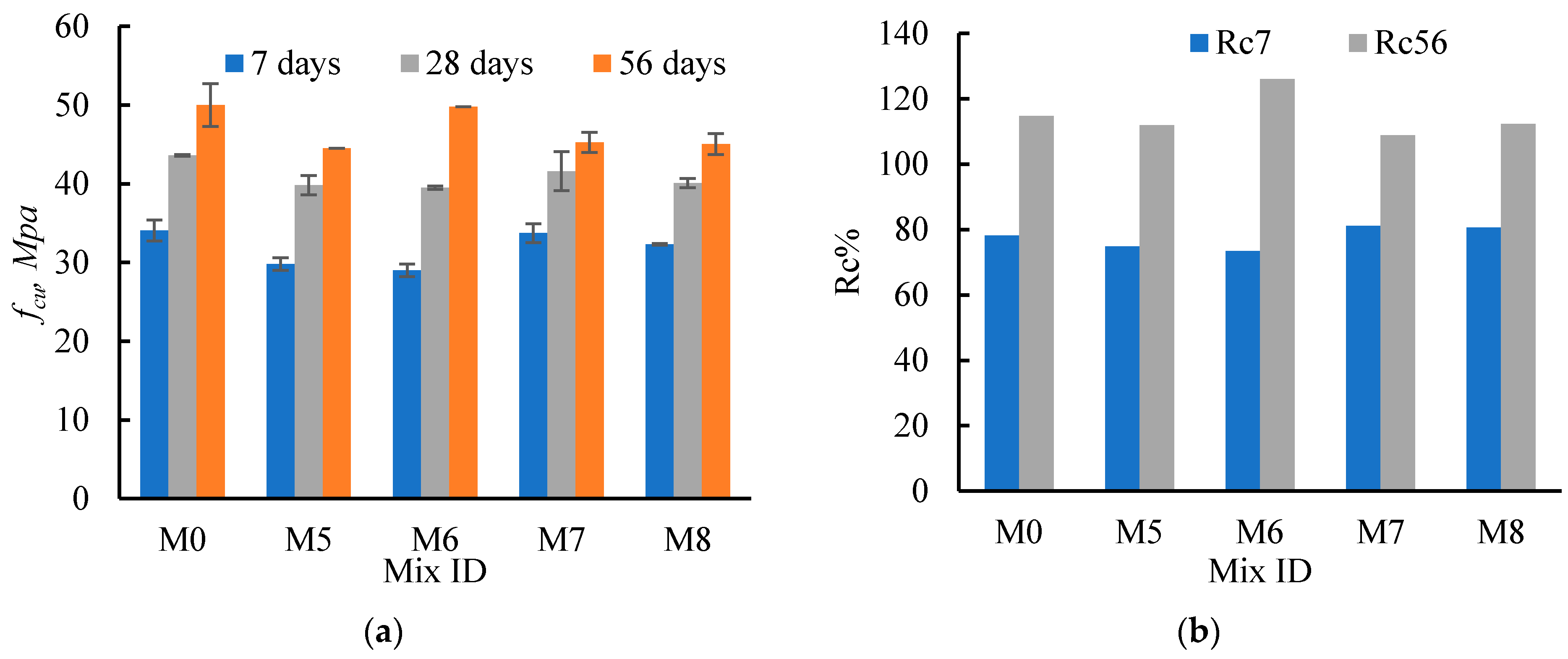

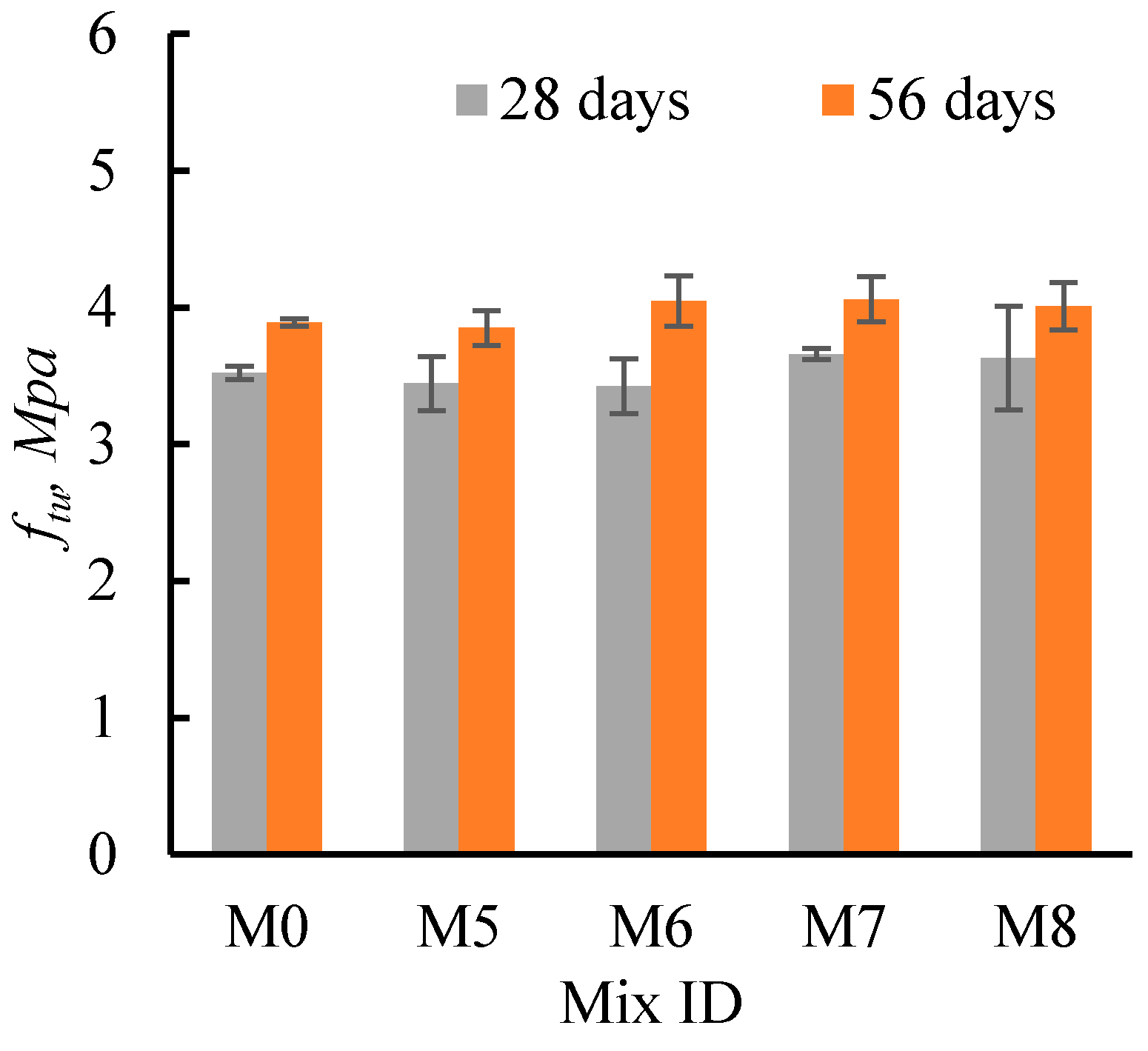
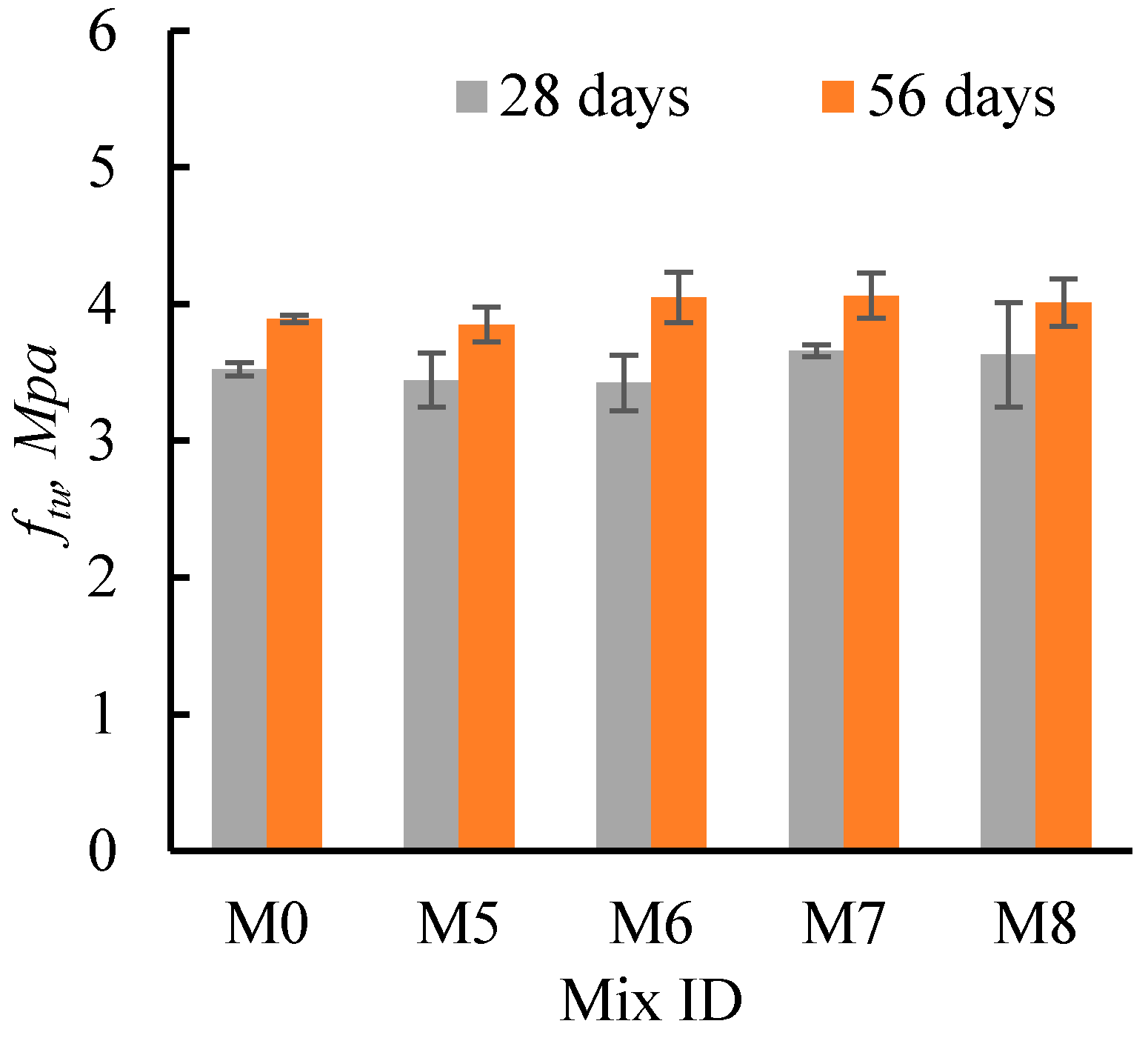



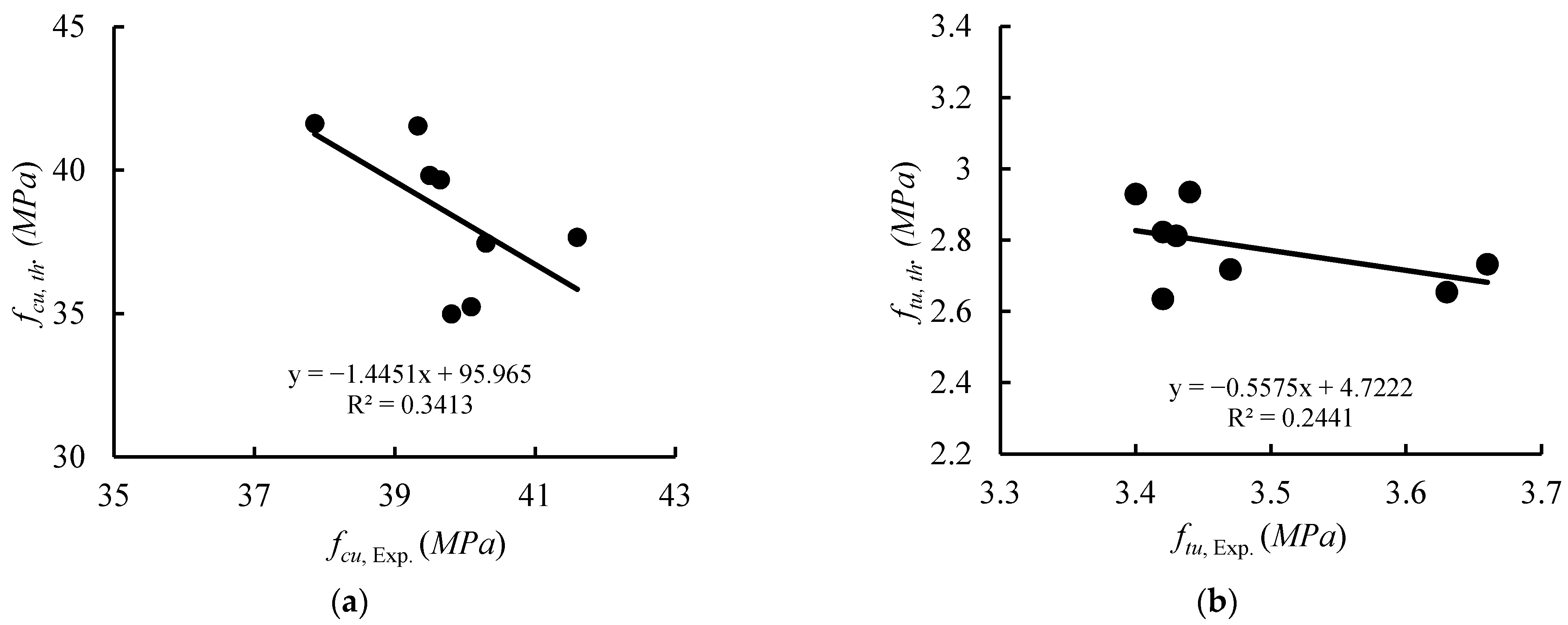
| Physical Properties | Coarse NA | CRCA | Natural Sand | FRCA |
|---|---|---|---|---|
| Apparent specific gravity (kg/m3) | 2.95 | 2.76 | 2.71 | 2.64 |
| Bulk specific gravity (SSD) (gr/cm3) | 2.86 | 2.57 | 2.28 | 2.15 |
| Bulk specific gravity (GD) (gr/cm3) | 2.81 | 2.46 | 2.03 | 1.86 |
| Water absorption (%) | 1.77 | 4.32 | 10.96 | 13.82 |
| Moisture content (%) | 0.93 | 1.25 | 2.73 | 2.37 |
| Item | SiO2 | CaO | AL2O3 | Fe2O3 | MgO | SO3 | LOI |
|---|---|---|---|---|---|---|---|
| OPC | 21.28 | 64.64 | 5.60 | 3.42 | 2.06 | 2.12 | 0.88 |
| RCP | 66.23 | - | 9.61 | 11.84 | 12.32 | - | - |
| Group | Mix ID | Recycled Aggregate (%) | RCP (%) | Aggregates (kg) | Water (kg) | Cement (kg) | |||
|---|---|---|---|---|---|---|---|---|---|
| Natural Sand | Natural Basalt | FRCA | CRCA | ||||||
| Control | M0 | 0 | 0 | 643 | 1016 | 0 | 0 | 200 | 400 |
| CRCA | M1 | 20 | 0 | 643 | 812.8 | 0 | 203.2 | 200 | 400 |
| M2 | 40 | 0 | 643 | 609.6 | 0 | 406.4 | 200 | 400 | |
| M3 | 60 | 0 | 643 | 406.4 | 0 | 609.6 | 200 | 400 | |
| M4 | 80 | 0 | 643 | 203.2 | 0 | 812.8 | |||
| FRCA | M5 | 20 | 0 | 514.5 | 1016 | 128.6 | 0 | 200 | 400 |
| M6 | 40 | 0 | 385.9 | 1016 | 257.3 | 0 | 200 | 400 | |
| M7 | 60 | 0 | 257.3 | 1016 | 385.9 | 0 | 200 | 400 | |
| M8 | 80 | 0 | 128.6 | 1016 | 514.5 | 0 | 200 | 400 | |
| RCP | M9 | 0 | 5 | 643 | 1016 | 0 | 0 | 200 | 380 |
| M10 | 0 | 10 | 643 | 1016 | 0 | 0 | 200 | 360 | |
| M11 | 0 | 20 | 643 | 1016 | 0 | 0 | 200 | 320 | |
| Group | Mix ID | Specimen No. | fcu,7 MPa | Mean (σµ) MPa | µ7 % | fcu,28 MPa | Mean (σµ) MPa | µ28 % | fcu,56 MPa | Mean (σµ) MPa | µ56 % | µ28/7 % | µ56/28 % |
|---|---|---|---|---|---|---|---|---|---|---|---|---|---|
| Control | M0 | 1 | 35.60 | 34.07 (±1.34) | 0.0 | 43.50 | 43.60 (±0.10) | 0.0 | 52.48 | 50.02 (±2.72) | 0.0 | 27.98 | 14.7 |
| 2 | 33.10 | 43.70 | 50.48 | ||||||||||
| 3 | 33.50 | 43.60 | 47.10 | ||||||||||
| CRCA | M1 | 1 | 28.10 | 28.17 (±1.00) | 17.3 | 38.50 | 39.33 (±0.80) | 9.80 | 44.93 | 44.82 (±0.27) | 10.4 | 39.64 | 13.9 |
| 2 | 27.20 | 39.40 | 44.51 | ||||||||||
| 3 | 29.20 | 39.69 | 45.01 | ||||||||||
| M2 | 1 | 27.70 | 29.33 (±1.20) | 13.9 | 39.87 | 39.65 (±0.24) | 9.10 | 45.81 | 45.33 (±0.80) | 9.40 | 35.18 | 14.3 | |
| 2 | 30.10 | 39.40 | 45.78 | ||||||||||
| 3 | 28.80 | 39.69 | 44.40 | ||||||||||
| M3 | 1 | 28.70 | 30.40 (±1.61) | 10.8 | 41.00 | 40.30 (±0.72) | 7.60 | 46.60 | 45.47 (±0.99) | 9.10 | 32.58 | 12.8 | |
| 2 | 30.60 | 39.57 | 45.00 | ||||||||||
| 3 | 31.90 | 40.34 | 44.80 | ||||||||||
| M4 | 1 | 28.20 | 28.37 (±1.26) | 16.7 | 37.48 | 37.86 (±0.87) | 13.2 | 40.35 | 40.86 (±0.66) | 18.3 | 33.47 | 7.90 | |
| 2 | 29.70 | 38.85 | 40.98 | ||||||||||
| 3 | 27.20 | 37.25 | 40.25 | ||||||||||
| FRCA | M5 | 1 | 30.60 | 29.81 (±0.80) | 12.5 | 40.54 | 39.81 (±1.22) | 8.70 | 42.83 | 44.53 (±0.00) | 11.0 | 33.57 | 11.8 |
| 2 | 29.00 | 40.50 | 45.54 | ||||||||||
| 3 | 29.82 | 38.40 | 45.22 | ||||||||||
| M6 | 1 | 29.80 | 29.01 (±0.80) | 14.8 | 39.63 | 39.50 (±0.21) | 9.40 | 47.86 | 49.78 (±0.00) | 0.50 | 36.14 | 26.0 | |
| 2 | 28.20 | 39.61 | 54.71 | ||||||||||
| 3 | 29.04 | 39.26 | 46.49 | ||||||||||
| M7 | 1 | 32.50 | 33.73 (±1.20) | 1.0 | 40.64 | 41.60 (±2.46) | 4.60 | 46.49 | 45.25 (±1.28) | 9.50 | 23.33 | 8.80 | |
| 2 | 34.90 | 44.40 | 43.93 | ||||||||||
| 3 | 33.80 | 39.77 | 45.32 | ||||||||||
| M8 | 1 | 32.40 | 32.30 (±0.10) | 5.2 | 39.98 | 40.09 (±0.57) | 8.10 | 45.71 | 45.04 (±1.32) | 10.0 | 24.11 | 12.4 | |
| 2 | 32.30 | 40.70 | 43.52 | ||||||||||
| 3 | 32.20 | 39.58 | 45.89 | ||||||||||
| M9 | 1 | 32.02 | 32.01 (±0.06) | 6.0 | 38.73 | 38.80 (±0.50) | 11.0 | 44.60 | 44.81 (±0.55) | 10.4 | 21.20 | 6.70 | |
| 2 | 31.95 | 39.33 | 45.44 | ||||||||||
| 3 | 32.07 | 38.34 | 44.40 | ||||||||||
| RCP | M10 | 1 | 22.34 | 22.93 (±0.84) | 32.7 | 43.39 | 43.30 (±0.32) | 0.70 | 46.90 | 47.61 (±0.67) | 4.80 | 88.81 | 3.70 |
| 2 | 23.90 | 43.57 | 48.24 | ||||||||||
| 3 | 22.56 | 42.94 | 47.70 | ||||||||||
| M11 | 1 | 22.89 | 21.57 (±1.24) | 36.7 | 39.70 | 38.27 (±2.32) | 12.2 | 41.20 | 42.43 (±1.07) | 15.2 | 77.39 | 11.4 | |
| 2 | 20.42 | 39.52 | 43.00 | ||||||||||
| 3 | 21.41 | 35.59 | 43.10 |
| Group | Mix ID | Specimen No. | ftu,28 MPa | Mean (σµ) MPa | µt28% | ftu,56 MPa | Mean (σµ) MPa | µt56 % | µt56/28 % | ftu,28/fcu,28 % | ftu,56/fcu,56 % |
|---|---|---|---|---|---|---|---|---|---|---|---|
| Control | M0 | 1 | 3.48 | 3.52 (±0.05) | 0.00 | 3.92 | 3.89 (±0.03) | 0.00 | 10.45 | 8.08 | 7.78 |
| 2 | 3.58 | 3.88 | |||||||||
| 3 | 3.51 | 3.87 | |||||||||
| CRCA | M1 | 1 | 3.45 | 3.40 (±0.04) | −3.42 | 3.86 | 3.69 (±0.16) | −5.02 | 8.61 | 8.65 | 8.24 |
| 2 | 3.37 | 3.53 | |||||||||
| 3 | 3.39 | 3.69 | |||||||||
| M2 | 1 | 3.51 | 3.43 (±0.10) | −2.63 | 3.56 | 3.59 (±0.05) | −7.60 | 4.81 | 8.65 | 7.93 | |
| 2 | 3.31 | 3.57 | |||||||||
| 3 | 3.47 | 3.65 | |||||||||
| M3 | 1 | 3.54 | 3.47 (±0.08) | −1.40 | 3.82 | 3.97 (±0.31) | 1.98 | 14.24 | 8.62 | 8.73 | |
| 2 | 3.39 | 4.32 | |||||||||
| 3 | 3.49 | 3.77 | |||||||||
| M4 | 1 | 3.40 | 3.42 (±0.06) | −2.88 | 3.43 | 3.47 (±0.03) | −10.90 | 1.33 | 9.03 | 8.48 | |
| 2 | 3.49 | 3.49 | |||||||||
| 3 | 3.38 | 3.47 | |||||||||
| FRCA | M5 | 1 | 3.66 | 3.44 (±0.20) | −2.24 | 4.00 | 3.85 (±0.13) | 0.26 | 13.27 | 8.65 | 8.76 |
| 2 | 3.29 | 3.78 | |||||||||
| 3 | 3.38 | 3.78 | |||||||||
| M6 | 1 | 3.27 | 3.42 (±0.20) | −2.88 | 3.87 | 4.05 (±0.18) | 5.40 | 19.78 | 8.67 | 8.24 | |
| 2 | 3.34 | 4.24 | |||||||||
| 3 | 3.65 | 4.05 | |||||||||
| M7 | 1 | 3.67 | 3.66 (±0.04) | 3.87 | 4.25 | 4.06 (±0.17) | 5.40 | 12.08 | 8.79 | 9.06 | |
| 2 | 3.61 | 3.96 | |||||||||
| 3 | 3.70 | 3.96 | |||||||||
| M8 | 1 | 3.21 | 3.63 (±0.36) | 3.05 | 4.20 | 4.01 (±0.17) | 3.09 | 10.49 | 9.05 | 8.90 | |
| 2 | 3.95 | 3.86 | |||||||||
| 3 | 3.73 | 3.96 | |||||||||
| RCP | M9 | 1 | 3.88 | 3.76 (±0.11) | 6.81 | 4.02 | 4.01 (±0.03) | 3.09 | 6.68 | 9.69 | 8.95 |
| 2 | 3.66 | 3.99 | |||||||||
| 3 | 3.74 | 4.03 | |||||||||
| M10 | 1 | 3.90 | 3.76 (±0.16) | 6.81 | 3.88 | 3.90 (±0.07) | 0.26 | 3.72 | 8.68 | 8.19 | |
| 2 | 3.58 | 3.97 | |||||||||
| 3 | 3.79 | 3.83 | |||||||||
| M11 | 1 | 3.24 | 3.42 (±0.16) | −2.92 | 3.87 | 3.81 (±0.09) | −2.05 | 11.44 | 8.93 | 8.98 | |
| 2 | 3.47 | 3.85 | |||||||||
| 3 | 3.54 | 3.70 |
Publisher’s Note: MDPI stays neutral with regard to jurisdictional claims in published maps and institutional affiliations. |
© 2021 by the authors. Licensee MDPI, Basel, Switzerland. This article is an open access article distributed under the terms and conditions of the Creative Commons Attribution (CC BY) license (https://creativecommons.org/licenses/by/4.0/).
Share and Cite
Sharaky, I.; Issa, U.; Alwetaishi, M.; Abdelhafiz, A.; Shamseldin, A.; Al-Surf, M.; Al-Harthi, M.; Balabel, A. Strength and Water Absorption of Sustainable Concrete Produced with Recycled Basaltic Concrete Aggregates and Powder. Sustainability 2021, 13, 6277. https://doi.org/10.3390/su13116277
Sharaky I, Issa U, Alwetaishi M, Abdelhafiz A, Shamseldin A, Al-Surf M, Al-Harthi M, Balabel A. Strength and Water Absorption of Sustainable Concrete Produced with Recycled Basaltic Concrete Aggregates and Powder. Sustainability. 2021; 13(11):6277. https://doi.org/10.3390/su13116277
Chicago/Turabian StyleSharaky, Ibrahim, Usama Issa, Mamdooh Alwetaishi, Ahmed Abdelhafiz, Amal Shamseldin, Mohammed Al-Surf, Mosleh Al-Harthi, and Ashraf Balabel. 2021. "Strength and Water Absorption of Sustainable Concrete Produced with Recycled Basaltic Concrete Aggregates and Powder" Sustainability 13, no. 11: 6277. https://doi.org/10.3390/su13116277
APA StyleSharaky, I., Issa, U., Alwetaishi, M., Abdelhafiz, A., Shamseldin, A., Al-Surf, M., Al-Harthi, M., & Balabel, A. (2021). Strength and Water Absorption of Sustainable Concrete Produced with Recycled Basaltic Concrete Aggregates and Powder. Sustainability, 13(11), 6277. https://doi.org/10.3390/su13116277









